7 Steps for a High-Impact Account-Based Marketing Strategy
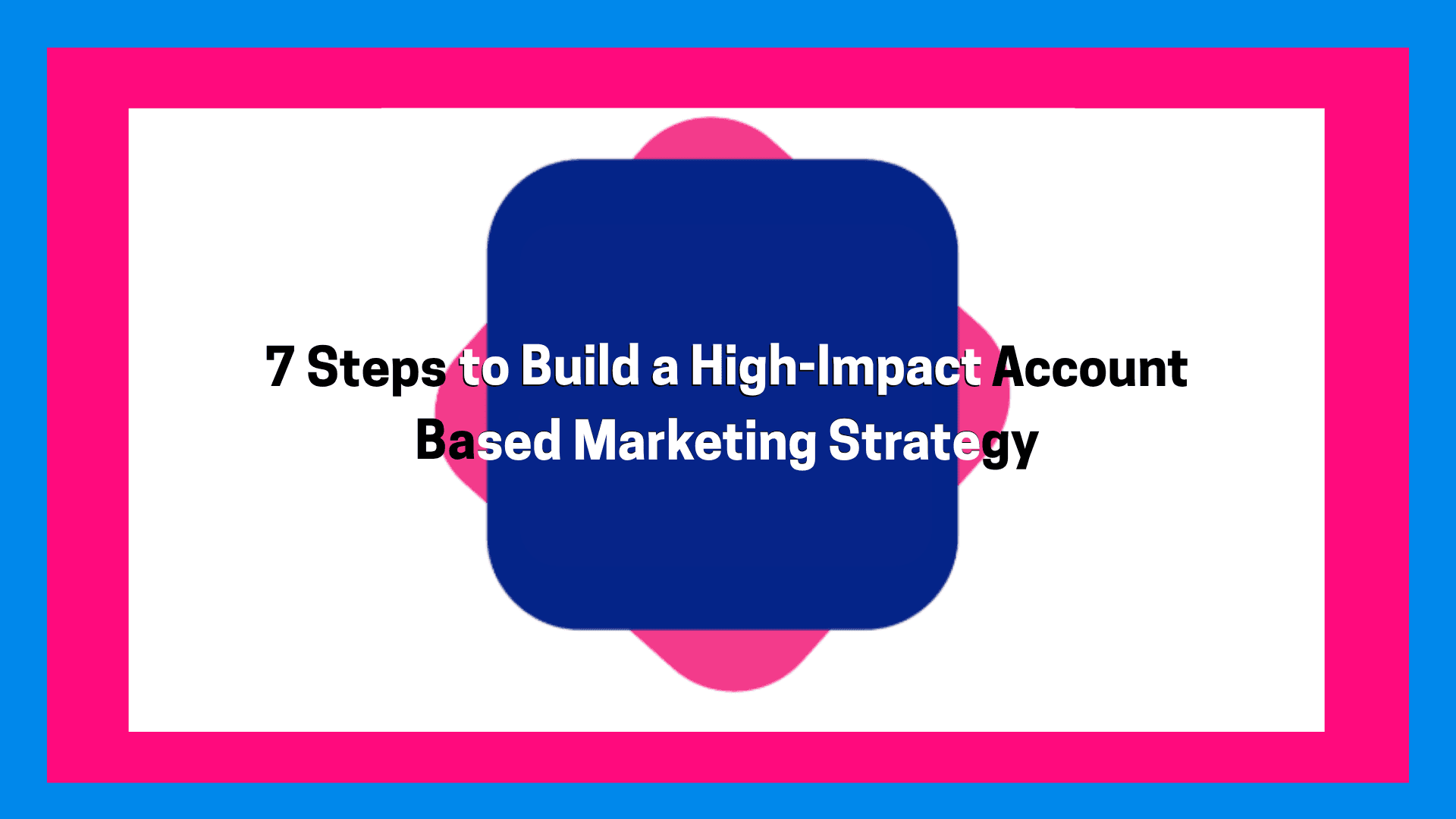
Add a Table of Contents
TL;DR
|
Struggling to close deals with the right customers? Many B2B SaaS companies waste time and resources on leads that never convert. Traditional marketing funnels often cast too wide a net, missing the high-value accounts that truly drive growth.
That's where account-based marketing (ABM) comes in. ABM flips the sales funnel, allowing you to concentrate on personalized engagement with your most valuable accounts. But for ABM to work, it’s not just about targeting a few key prospects; it’s about implementing a strategic, repeatable process that ensures consistent results.
In fact, companies that excel at ABM see a 208% higher marketing revenue than those who don't. Additionally, 85% of marketers report that ABM improves customer retention rates, and 80% say it increases customer lifetime value. These statistics underscore the effectiveness of ABM in driving meaningful business outcomes.
What is Account-Based Marketing?
Account-based marketing (ABM) is a highly focused growth strategy where marketing and sales teams align to target and engage specific high-value accounts with tailored, personalized campaigns, unlike traditional marketing, which casts a wide net. ABM zooms in on a select group of prospects that have the highest potential to convert.
The essence of a successful ABM strategy lies in understanding the unique needs of each target account, researching their challenges, and delivering content and experiences that resonate deeply with them. By focusing on relevance rather than volume, ABM drives stronger engagement and better outcomes.
This strategy involves:
Identifying Target Accounts: Selecting organizations that align with your Ideal Customer Profile (ICP).
Personalizing Outreach: Crafting tailored content and messaging that resonates with each account's specific pain points and objectives.
Coordinated Execution: Aligning marketing and sales efforts to deliver a seamless and consistent experience across all touchpoints.
The goal is to establish deeper relationships with key accounts, resulting in higher engagement, larger deal sizes, and enhanced ROI.
Example:SmartCue could implement an ABM strategy by offering personalized, interactive product demo to its top-tier prospects, showing exactly how its sales enablement platform addresses their unique challenges.
For instance, if SmartCue is targeting a large enterprise in the tech space, the demo could include tailored sales content templates and a walkthrough of how SmartCue can integrate seamlessly with the company’s existing CRM system, improving sales funnel efficiency.
This level of personalization creates a powerful, customer-centric experience that positions SmartCue as the ideal solution for that account.
Why Should You Use Account-Based Marketing?
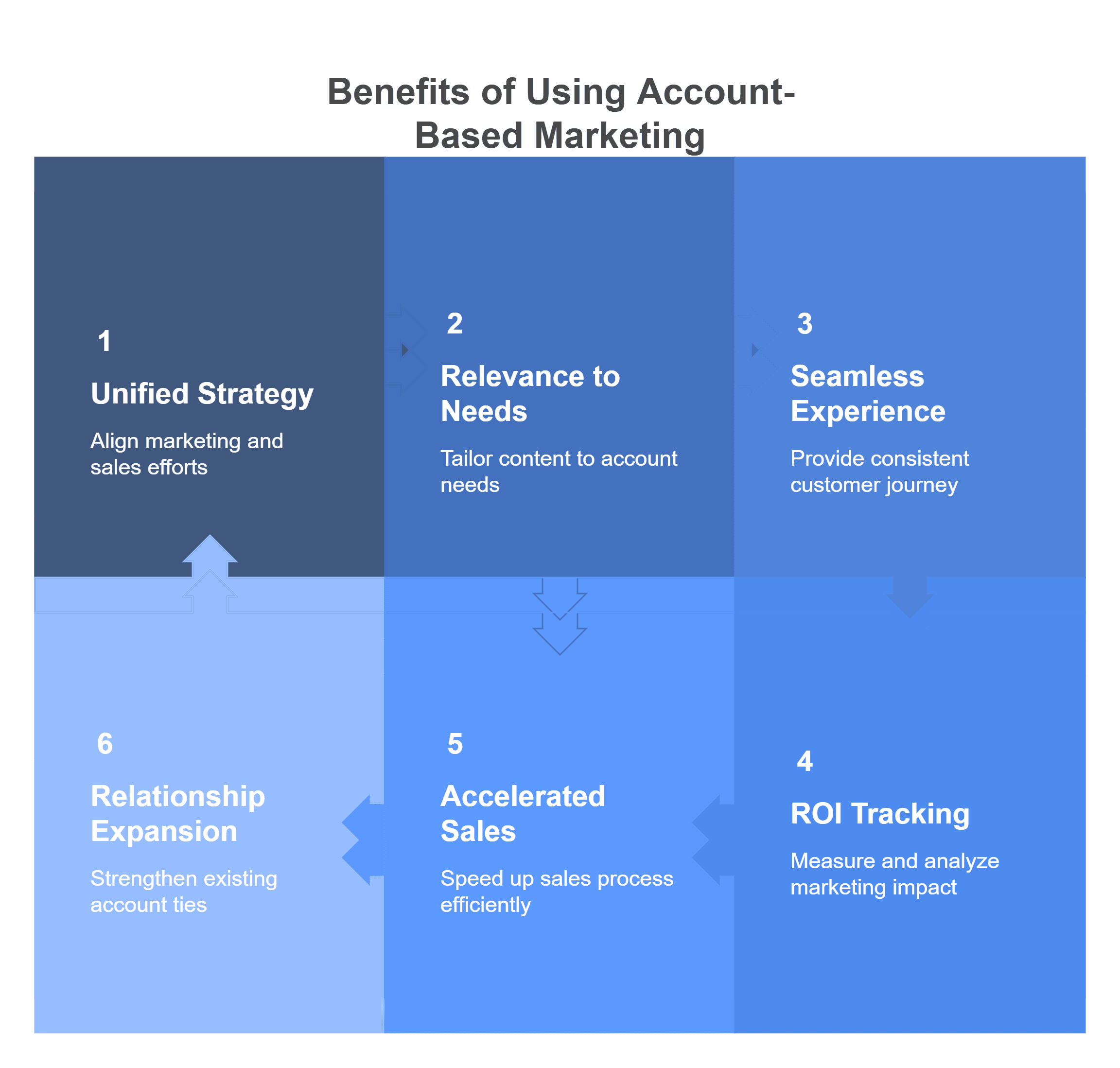
ABM isn’t just about generating leads; it’s about cultivating high-value relationships with the proper accounts. When marketing and sales teams unite around a common goal, the magic happens. By working together, they focus on the accounts that truly matter, creating personalized and targeted strategies that not only attract attention but also drive meaningful results. Here’s how ABM transforms your business:
1. How Does ABM Create a Unified Strategy for Better Results?
In traditional sales funnels, marketing and sales teams often feel disconnected, as each works with its own strategies and goals. With ABM, both teams align on who they’re targeting, what messaging resonates, and how to approach engagement.
This unity doesn’t just streamline workflows; it drives greater collaboration and results. When both teams are aligned, the entire sales process becomes smoother and more efficient, reducing the confusion caused by disconnected leads.
2. What Makes ABM Messaging So Relevant for Target Accounts?
ABM helps you move away from generic messaging that gets lost in the noise. By understanding the specific challenges and goals of your high-value accounts, you craft content that speaks directly to them.
Whether it’s a custom email, a personalized demo, or a strategic piece of content, ABM ensures that your outreach is not just relevant but truly impactful. The result? Higher engagement, more clicks, and an increase in conversions from the right prospects.
3. How Does ABM Create a Consistent Customer Journey?
With ABM, your brand’s message doesn’t get lost in translation. Every touchpoint, from your first email to your final demo, is aligned to create a consistent experience that builds trust. By delivering tailored messaging at each stage of the journey, you demonstrate that your brand understands the specific needs of each account, fostering stronger and more meaningful relationships.
Want to deliver consistent, personalized demos that seal the deal? Try SmartCue and see how interactive product tours can power your ABM success.
4. Why Is ROI Tracking Easier with ABM?
Traditional campaigns often leave you guessing: which part of your strategy worked, and which didn’t? With ABM, you can measure results with precision. Since your efforts are focused on specific accounts, tracking becomes more straightforward. By analyzing the impact on individual accounts, you gain valuable insights into what drives engagement, sales, and ultimately, revenue.
5. How Does ABM Speed Up the Sales Process?
Time is of the essence in the sales process, especially with high-value accounts. ABM eliminates unnecessary steps, keeping your focus on delivering the right content at the right time. By addressing the key decision-makers’pain points immediately, your team can guide them more efficiently through the sales funnel, reducing the time it takes to close a deal and accelerating your sales cycle.
6. In What Ways Can ABM Strengthen Existing Client Relationships?
ABM isn’t just for landing new clients; it’s also a powerful tool for growing existing accounts. By targeting specific needs within your current customer base, you can deepen relationships, open doors for upsells, and create opportunities for referrals. With ABM, the focus isn’t just on landing new logos, but also on driving more value from your current accounts over time.
How to Actually Build an Account-Based Marketing Strategy That Works?
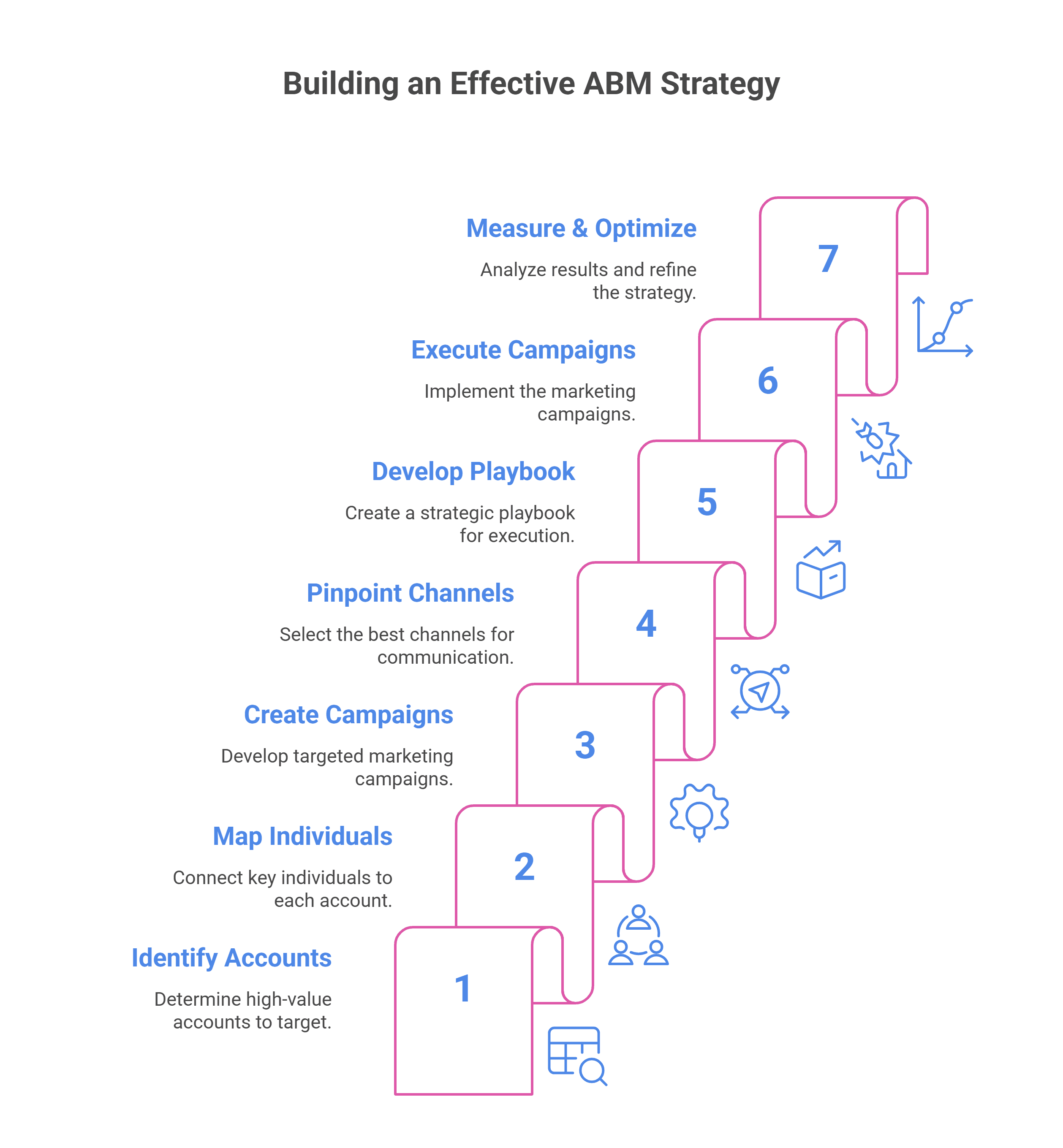
Chasing high-value clients with generic marketing campaigns won’t get you far; it’s time to move beyond the "one-size-fits-all" approach. To land your ideal accounts, you need a strategy that’s as tailored as your outreach. Here’s how to create an ABM strategy that cuts through the noise and drives real, measurable results.
Step 1: How to Identify High-Value Accounts that You Should Target First?
Start by defining who you want to target. These aren’t just “leads”, they’re accounts that match your ideal customer profile (ICP) in size, industry, revenue, and potential lifetime value.
Pro tip: Use sales data, CRM insights, and even your support tickets to identify patterns among your top customers. That’s where you’ll find your next best ones.
Step 2: Why Should You Map Individuals You Need to Engage Within Each Account?
You’re not selling to a company. You’re selling to people inside that company.
Identify key decision-makers, champions, blockers, and influencers in each account. This helps you personalize your outreach based on role, not just company name.
Head of Sales: Focus on pain-point driven messaging that speaks to sales challenges.
RevOps: Prioritize data insights and seamless integrations to streamline operations.
CFO: Emphasize ROI, cost-effectiveness, and long-term financial impact.
Step 3: How Can You Create Campaigns That Truly Speak to Each Account?
This is where your messaging and content get specific.
Each account (or account tier) should receive campaigns tailored to their needs, goals, and pain points.
Assets to include:
Personalized email sequences
Custom one-pagers or competitor comparisons
LinkedIn message templates
You’re building campaigns for them, not just about you.
Looking to deliver guided, personalized demos that truly connect? Book a live demo to see how we can help power your ABM campaigns.
Step 4: How to Pinpoint Channels to Reach Stakeholders Effectively?
Not all your prospects hang out in the same place.
Your job is to identify where each stakeholder is most active, whether via email, LinkedIn, Slack communities, or events, and tailor the touchpoints accordingly.
Great account based marketing strategies meet people where they are, not where it’s convenient for you.
Step 5: Why Do You Need an ABM Playbook and What Should It Include?
To stay consistent across accounts and teams, build a repeatable playbook.
This includes messaging guidelines, response templates, lead scoring criteria, and guidelines for outreach timing.
Think of it as your ABM command center, so everyone’s aligned, whether you're scaling to 10 or 100 accounts.
Step 6: What’s the Best Way to Execute Your ABM Campaigns?
With everything mapped out, it’s time to go live.
Use your playbook to launch targeted campaigns, hand off warm leads to sales, and ensure seamless transitions from marketing to sales outreach.
Bonus tip: Maintain close communication between sales and marketing during this phase. Quick feedback loops = faster results.
Step 7: How Do You Measure ABM Success and Keep Improving?
No ABM campaign is ever "done."
Track performance by account: who opened what, which touchpoint drove action, and where deals are stalling.
Use this data to double down on what’s working, and toss what isn’t.
ABM is a cycle: Test → Learn → Tweak → Repeat.
What Are Some Account-Based Marketing Examples That Worked Brilliantly and Why?
It’s one thing to understand account-based marketing in theory. It’s another to see it drive results in the real world.
Below, we’ll break down three detailed ABM strategy examples, each from a different industry, and explain what they did, how they did it, and why it worked.
1. Restaurant Furniture Plus
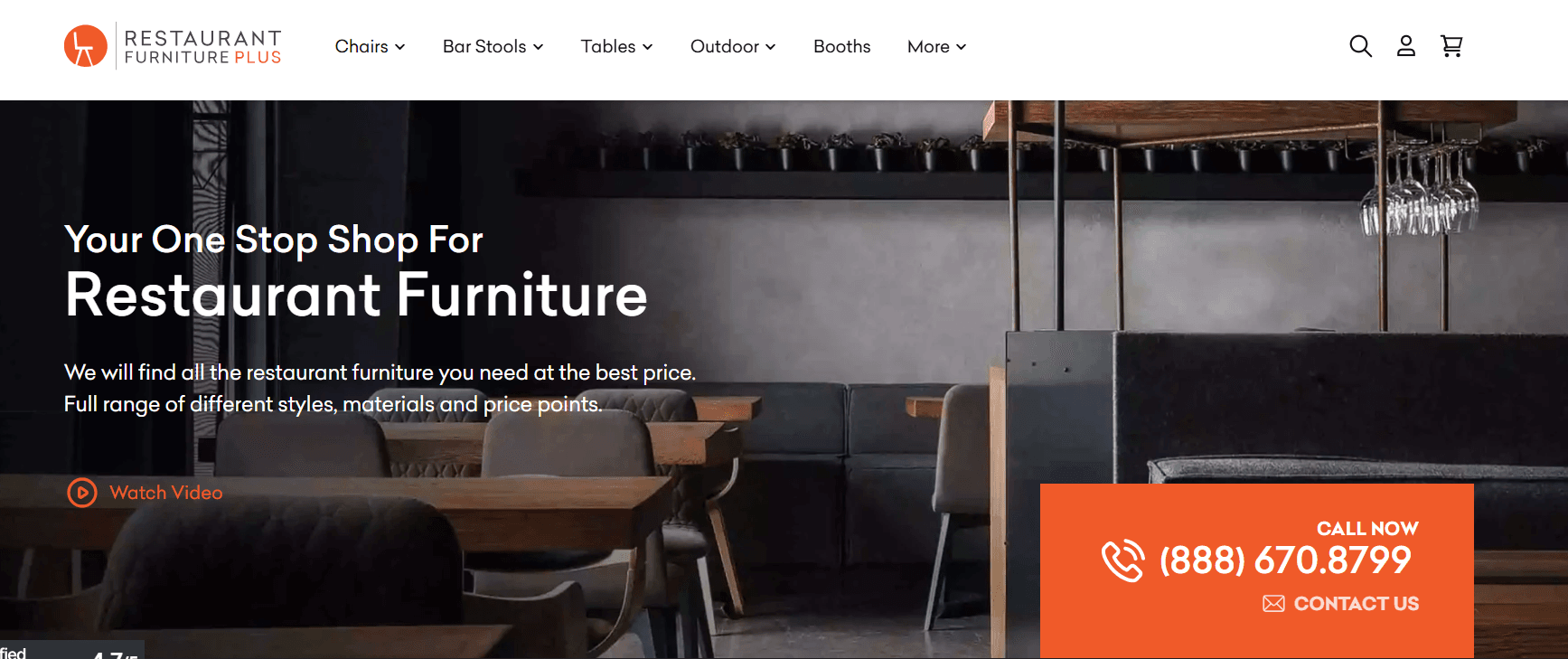
Restaurant Furniture Plus is a commercial furniture supplier for restaurants and hospitality businesses across the U.S. For years, they relied on Google Ads and SEO to drive leads. And it worked, kind of. Leads came in, but they were inconsistent and not always a great fit.
What was the ABM Challenge?
The company realized its highest-value customers weren’t the one-time buyers. Their sweet spot? Multi-location restaurant chains that needed repeat orders, brand consistency, and scale.
What They Did
They built a focused account based marketing strategy aimed at mid-sized chains expanding into new markets. Here’s how they did it:
Step 1: Identify high-value accounts – They analyzed past orders and found that restaurant chains with 5–20 locations were the most profitable.
Step 2: Map buyers – Instead of generic outreach, they identified operations managers and purchasing directors as key decision-makers.
Step 3: Personalize content – They created pitch decks showing how they could streamline large orders, offer style consistency, and handle logistics.
Step 4: Target smarter – They shifted the budget from broad ads to LinkedIn and email campaigns tailored to those specific accounts.
What was the Result?
Sales became more predictable.
Ad spend went down.
Repeat orders from high-value clients went up.
This was a perfect example of a niche business building an ABM engine that prioritized long-term value over short-term volume.
2. HealthLink Dimensions

HealthLink Dimensions offers healthcare data solutions, including provider directories, claim routing, and data cleaning, for payers and healthcare networks.
What was the ABM Challenge?
They wanted to close more deals with health insurance providers. However, with long buying cycles, complex organizational charts, and limited brand recognition in that space, they kept hitting walls.
What They Did
They knew a spray-and-pray model wouldn’t cut it. So, they built an enterprise-grade ABM strategy designed to win trust and earn attention in a complex market.
Step 1: Define key accounts – They focused on mid-sized insurance companies with regional presence and known data issues.
Step 2: Create tailored content – Each campaign included personalized messaging, use-case decks for provider matching, and cost-saving scenarios.
Step 3: Align marketing with sales – Marketing ran display and LinkedIn ads to generate familiarity, while sales followed up with warm, intent-driven conversations.
Step 4: Multi-stakeholder outreach – They didn’t just target one contact, they engaged separately with operations, claims, analytics, and C-suite leaders.
What was the Result?
They saw a 234% increase in new pipeline from these targeted accounts. More importantly, their sales team now had warm entry points, better conversations, and much shorter sales cycles.
This is a great account based marketing strategy example of using ABM to break into a difficult vertical where standard lead-gen had failed.
3. BlueYonder
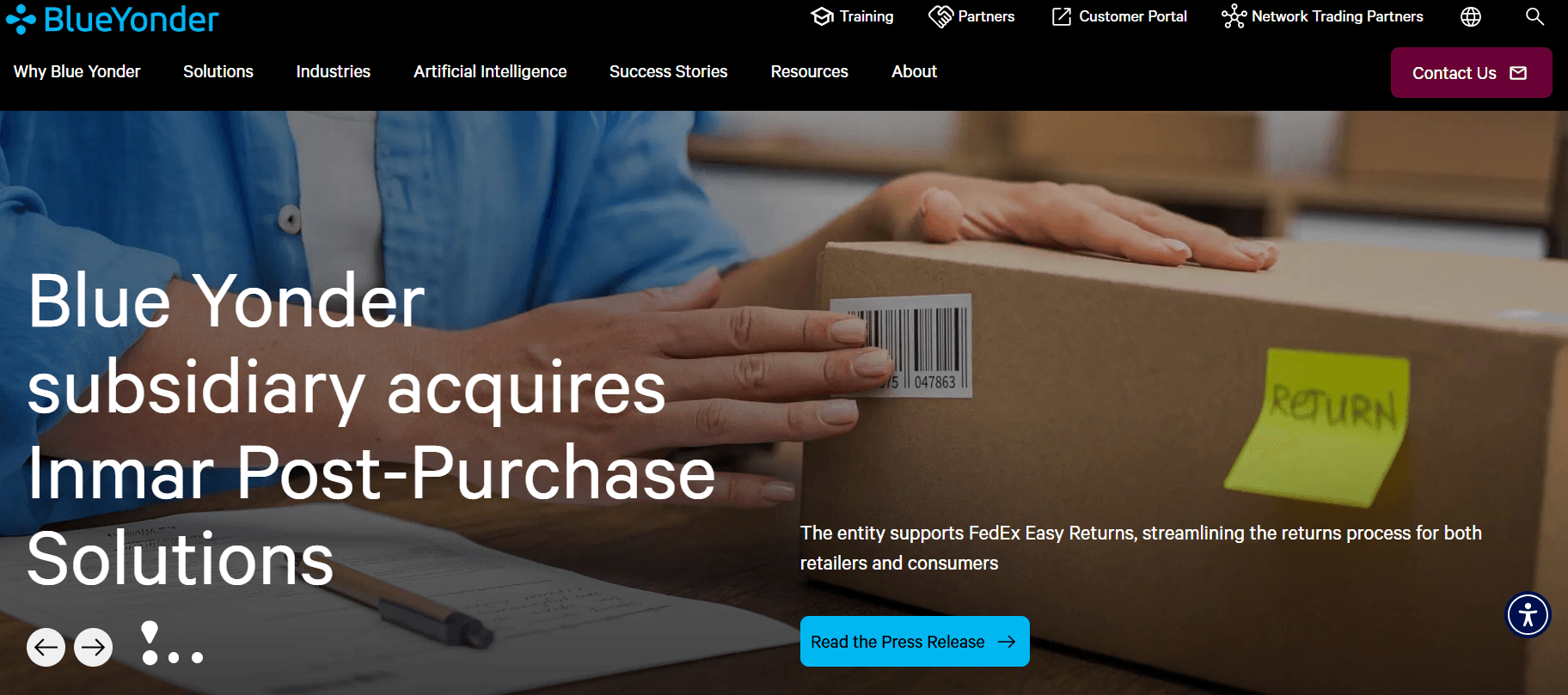
BlueYonder is a global leader in AI-powered supply chain management software. They’d had success in the mid-market, but wanted to move up and close enterprise deals with major retail and logistics brands.
What was the ABM Challenge?
Larger accounts meant longer sales cycles, more decision-makers, and much higher stakes. To crack these, they needed laser-focused targeting, tailored messaging, and tighter alignment between sales and marketing.
What They Did
They launched a small but powerful ABM pilot focused on just a handful of enterprise accounts.
Step 1: Select high-potential accounts – These were global retailers and logistics providers known to be investing in supply chain transformation.
Step 2: Customize the value narrative – Each account received unique materials: customer success stories relevant to their vertical, custom ROI calculators, and technical integration plans.
Step 3: Orchestrate outreach – Personalized landing pages, LinkedIn ads, direct mail, and follow-up calls were mapped across stakeholder roles.
Step 4: Align around the account – Sales and marketing worked from a single playbook to coordinate timing, messaging, and engagement strategy.
What was the Result?
The pilot generated $10 million in pipeline, yes, from just a handful of accounts. BlueYonder then scaled that model across its sales organization and shifted its go-to-market approach to an ABM-first strategy.
This wasn’t just a campaign. It became their blueprint for enterprise growth, and arguably their best account based marketing strategy to date.
What are the Key Takeaways from These ABM Success Stories?
If you’re thinking, “Okay, but what is account based marketing strategy that works for me?”, here’s what all three examples had in common:
They defined clear targets – No guessing. Just accounts that matched their ICPs.
They customized their message – No generic PDFs or mass email blasts.
They aligned internally – Sales and marketing moved as one team.
They played the long game – Fewer leads, but better ones. And it paid off.
Whether you’re in B2B tech, healthcare, or even niche retail, the account based marketing strategies that win are the ones rooted in research, personalization, and strategic execution.
Why Are SmartCue’s Personalized Demos a Game-Changer for ABM?
You've got the right target accounts. You've created the perfect outreach sequence. Now what?
The next step is showing, not just telling, how your solution solves their problem. That’s where SmartCue comes in.
SmartCue helps you create personalized, interactive product demos that are tailored to each account's exact pain points. Whether you’re targeting a Head of Sales who needs quick wins or a RevOps lead concerned about integrations, SmartCue lets you deliver a demo experience that speaks directly to their needs, without waiting on your product or engineering team.
Real ABM power comes when content meets context.
SmartCue gives you the tools to deliver that, one personalized demo at a time. Try a 14-day free trial.
Conclusion
Implementing a strong account-based marketing strategy requires a thorough understanding of your key accounts. The marketing and sales teams must also work together. When you focus on your ideal customer profiles and utilize intent data, your company can identify specific accounts with the most revenue potential. As your campaigns progress, continue to measure the results and make adjustments accordingly. This is needed to get the highest ROI.
By following best practices and utilising the right ABM tools, you can enhance brand awareness and increase lead generation. Over time, your customer accounts can become valuable sources of new revenue.
Frequently Asked Questions
How do you measure success in account based marketing?
Track key metrics such as engagement across marketing channels, customer acquisition cost, and average deal size. Monitor movement through the sales funnel, ROI per target account, and the impact of your ABM efforts on revenue growth. Utilize customer relationship management tools and account-based marketing (ABM) platforms to capture results clearly and consistently.
Can ABM be used by small businesses or startups?
Absolutely. A focused ABM approach helps startups prioritize the best leads, optimize resources, and tailor marketing content to a target audience that is a good fit. It’s ideal for businesses targeting specific individuals within target companies, where building deeper customer relationships is more important than reaching large groups with broad marketing tactics.
What are the three types of account-based marketing?
The three types of ABM are strategic ABM (1:1 marketing for enterprise customers), ABM Lite (1:few for a small set of target accounts), and programmatic ABM (1:many using automation and ABM platforms).
What is the difference between CRM and ABM?
While CRM systems manage customer data and contact information, ABM is a marketing approach where marketing teams and sales reps align to target the right accounts with personalized campaigns for higher ROI, using tools like marketing automation.
What is the key element to a successful ABM strategy?
The key element is aligning marketing efforts and sales around key stakeholders in the right accounts, delivering relevant content through social media, blog posts, and case studies, all measured by clear key performance indicators for higher ROI.
Comments
Your comment has been submitted successfully!